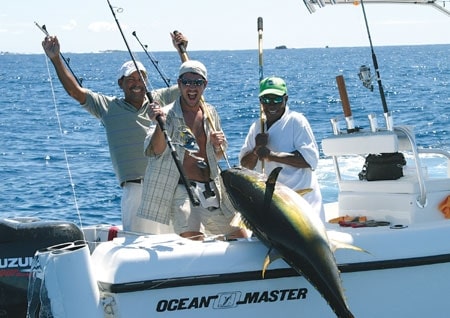
SHORT WORK: Angler Cedrik Djelassi (center) boated this 162-pound tuna in less than five minutes.
Photo: Al Ristori
There’s just no mistaking a yellowfin strike. And when your skipjack baits are rigged with large circle hooks, there’s not much you can do after the hit except hang on for dear life. That’s exactly what I planned to do.
Friend and Captain Hans Kaspersetz and I were off Isla Montuosa, Panama, with a mothership operation called Pesca Panama last January amid an unprecedented run of big yellowfin tuna. In what would soon come to be known as the Year of the Yellowfin, 92 hundred-plus-pound tuna-47 of those weighing 200 pounds or more-were boated before the run ended. A 302-pound fish was also caught. It didn’t take long for us to be deep into tuna while fishing waters that could eventually take the title as one of the world’s top destinations for mega-yellowfin.
There was a time I’d salivate at the mere thought of catching big tuna, but I now generally run in the other direction, especially when there are billfish or inshore species in the vicinity. It was, however, too late to escape the brute hooked to the business end of the 50W bent-butt standup outfit. Captain Travis Peterson had the strike drag set at 20 pounds, but it wasn’t long before I pushed it up to the full setting of 28 pounds with 80-pound line. Moving up to the bow, I leaned back on the tuna with a rod belt and harness, content to let the fish settle down and tow us, which is the key to catching big fish from a small boat. That’s when trouble struck. The fish was directly under me off the bow, and I was adding pressure on the line with gloved hands when a strap on the rod belt broke-twice. I scrambled to stay aboard while hanging onto the tuna and getting reset for that all-important final effort to break the fish out of its circling. After more than an hour, the 225-pound yellowfin (by formula) was in the boat.
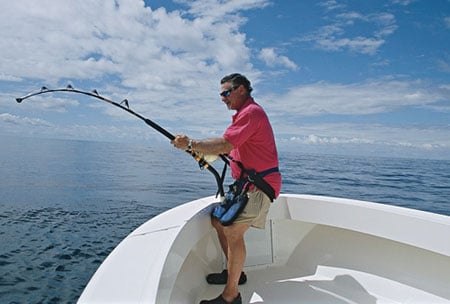
Photo: Al Ristori
The New Frontier
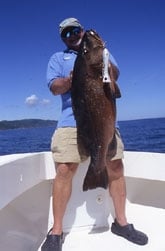
| |PLUG AWAY: Ferocious top-water strikes make cubera snapper an exciting target.|
Montuosa is the outermost island in the archipelago fished by boats working out of the famed Isla de Coiba area near Panama’s border with Costa Rica. When Bob Griffin opened his Club Pacifico de Panama operation on Coiba during the 1970s, Montuosa was the Bali Hai of all the surrounding islands. It looks exactly like the remote, uninhabited tropical island of my dreams. I had been there during an exploratory trip just before the club opened, and enjoyed great popping-plug action with rainbow runners over 20 pounds as well as the usual jacks and snappers. However, Griffin soon put Montuosa off limits because of monetary and safety concerns. Not only was a lot of precious fuel consumed in making the trip, but rescue would be a problem if a boat broke down during the long run. Thus, big-game fishing was primarily conducted at Hannibal Bank where black marlin were the target. In fact, tuna didn’t appear very often, and during my many trips to the camp I don’t recall any big yellowfin. Much has changed.
The Pesca Panama barge moves to various sites in the islands around Coiba, providing easier access to Montuosa. Fishing is done on 27-foot center console Ocean Masters. There are times when marlin and sailfish action is better there than at the nearby and more renowned Hannibal.
On our trip with Pesca Panama Fishing Charters, which books trips out of Phoenix, Arizona, Kaspersetz passed on tuna in favor of trying for sailfish in the same area. The lures were hardly out before one was raised and crashed a live scad I’d caught from the barge the night before. Kaspersetz had fun releasing that lively sail rather than breaking his back on a brute of a yellowfin.
We had a day of great inshore casting-the biggest attraction of the area for me-before heading back to Montuosa to cast plugs. There were birds working off the tip where we were surprised by a mixture of school yellowfin with jacks, snappers and rainbow runners. Kaspersetz even had a sailfish follow his popper. Most of the tuna were only 15- to 25-pounders, but when we ventured farther off, Kaspersetz plugged one in the 50-pound range.
We also watched a young French angler enjoy the luckiest day of his fishing career. Cedrik Djelassi had lost a long fight with a big tuna on heavy spinning gear the day before, but he seemingly could do no wrong this time with Captain Macho Gonzalez. Djelassi boated a 220-pound tuna on standup gear before hooking another big one on spinning tackle. That yellowfin charged the boat and was gaffed by the mate as it passed by. In less than five minutes the 162-pounder was onboard.
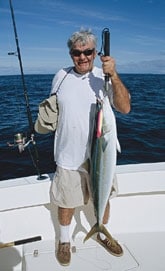
| |POT TOP: This rainbow runner jumped on a popper. Photo: Al Ristori|
As if that wasn’t enough good fortune for the day, Djelassi dropped a live bait down on standup tackle and hooked up again. However, this “tuna” presented us with a bill. The blue marlin eventually made one jump too many and slammed into the side of the boat, a blow that took a heavy toll, as the the crew was unable to revive it. All billfish are turned loose that can be released alive at Pesca Panama, but that one was brought in for an orphan’s home in nearby David and weighed 353 pounds. Djelassi added school yellowfin on poppers that day and boated a 115-pounder on spinning gear after a three-hour battle.
Since we were out there, Kaspersetz decided to fish a live bait and ended up regretting it 11/2 hours later when his knees gave out. I got stuck for another half an hour finishing a very feisty yellowfin that checked out at 185 pounds.
Though I’d fought enough big yellowfin to suit me, I did want to enjoy casting during the last full day to the 40- to 60-pounders that were mixed in with much smaller and larger tuna. After a 20-pounder threw the hooks at boatside, my next cast with a Yo-Zuri Surface Bull was grabbed by something much larger. Kaspersetz ended up reading a novel while I struggled with a 170-pounder for 51/2 hours on a big Shimano spinning reel mounted on a Lamiglas rod.
We were a lot closer to Montuosa when that fight ended, but after taking photos there was still enough daylight to slip over to the island and provide my patient partner with a bit of casting before the run back. Kaspersetz quickly released three bluefin trevally and a 15-pound mullet snapper, while I recovered in time to hook a 27-pound mullet snapper and get broken off by a big cubera. That’s part of the magic of the Isla de Coiba area: You can be fishing big game one minute and casting to some of the world’s most powerful inshore species the next.
Panama Planner
Pesca Panama is booking years in advance for their air-conditioned motorized barge that moves to various anchorages in the islands with its four 27-foot Ocean Masters. For information, call (800) 946-3474 or visit www.pescapanama.com.
The Coral Star is a converted Danish hospital ship with a fleet of small boats. For more information, call (866) 924-2837 or visit www.coralstar.com.
Panama Big Game Fishing Club is a shore-based operation on Isla Boca Brava, located between the city of David and Isla Montuosa. For information, call (866) 281-1225 or visit www.panamabiggamefishingclub.com.
Captain Tom Yust moors two boats-a 31-foot Bertram and a Mako 22-at Isla de Coiba. For more information, call (800) 800-0907 or visit www.coibadventure.com. – A.R.
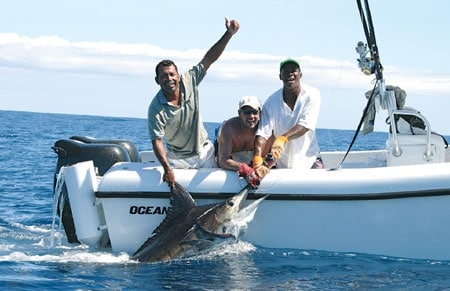
LAND OF PLENTY: Inshore and offshore action abound at Pesca Panama, ranging from a 350-pound marlin that charged the boat to Kaspersetz’s big roosterfish (bottom).
Photo: Al Ristori
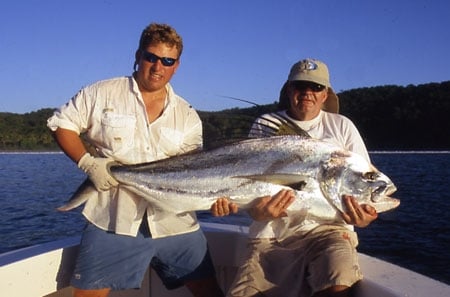
Photo: Al Ristori









